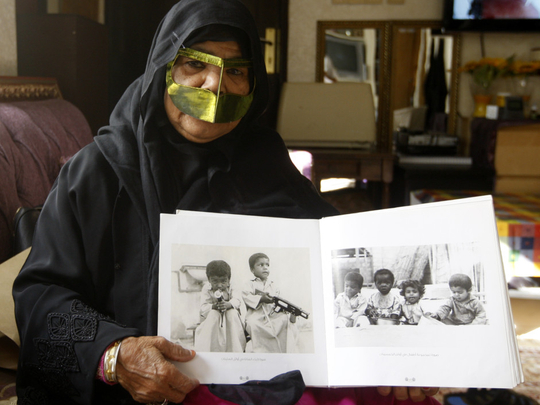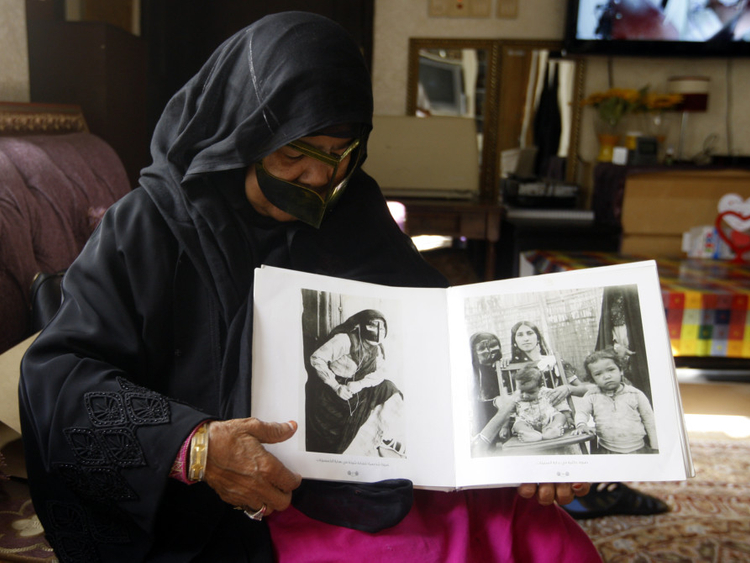
Dubai: As she was sitting on the living room couch, her grandson walked into the room grabbing the family’s attention with his new pirate costume. Shaikha’s first instinct was to take a picture with her mobile phone camera to capture the precious moment.
She then posed in front of the camera embracing her grandson to add to her album of abiding memories.
Shaikha Jasem Mohammad Mubarak Al Suwaidi, the first female Emirati photographer, was named the Mother of Emirati photographers in recognition of her work since she took up photography as a hobby at the age of 16 in the 1950s. She enjoyed learning new skills and photography was one dearest to her heart.
Now 79, Shaikha recalls: “I started taking pictures at the age of 17 even though people were not interested and discouraged me at times,” she recalled. “I didn’t pay much attention because my passion for photography began when I was 16 and, at 17, I was sure that taking pictures would make me happy.”
After her father passed away when she was around nine, her mother barely had enough money to support the two children.
Mohammad Sharif, a representative of the late Shaikh Saeed Al Maktoum, took responsibility for Shaikha and her family.
Sharif was responsible for translating telegraphs sent by Shaikh Saeed’s office into English in order to deliver them to an office located by the port where most ships arrived.
“My mother worked as a cook at Mohammad Sharif’s house and he would send me to Shaikhs and offices with telegraphs that needed to be delivered and that was how much he trusted me,” she recalls.
Shaikha said that being a woman she had to be careful when delivering the telegraphs to the men working in the office; she would slip the telegraphs between the metal bars of the office window to avoid any direct contact.
When she was sent to deliver the letters, she noticed some men exchanging papers with real-life images of people.
“I wondered for a while how it was possible for a person to have his exact likeness on a piece of paper,” Shaikha said. “Jeta, who worked as a writer in the office by the port, explained that the machine called the camera made it possible to print anything.”
Curiosity drove Shaikha to learn more about the camera and how to operate it as well.
Knowing that she was living with Mohammad Sharif, Jeta taught her how to take pictures and educated her about the different features found in the camera.
Shaikha recalls that the Agfa brand cameras used to be brought from India at the time. Gaining Jeta’s trust, Shaikha borrowed his camera to take as many pictures as she desired. “He trusted me to the extent that he allowed me to take the camera with me when I went to Bombay with Mohammad Sharif’s wife for her treatment,” she said. “I started taking pictures of the hospitals and sick people lying on their beds.”
Flipping through an album with some of her best photographs, there were several pictures where Shaikha was visible in front of the camera. She explained that with practice she had mastered setting the camera on automatic, placing it on a step or chair, giving her enough time to get back in front of the lens.
Seeing Shaikha’s passion for photography, Sharif, the man who raised her, gave her money to buy a camera for herself. Though the young photographer was overwhelmed with excitement, she found herself left with several negatives waiting to be developed.
“Mohammad Sharif gave me money to develop my photos, but I had so many negatives I was too shy to ask for more money to develop the rest of the negatives,” she explained.
Driven to learn new skills, Shaikha approached her neighbours, the daughters of Mohammad Habib, for help. Habib was the first Emirati doctor and his family developed personal photos of individuals for their passports.
“At first his daughters refused since it was a source of income for the family and they worried I might learn to make money out of it, but I explained that it was for my personal photographs,” said Shaikha.
She pointed to a big brown box and explained the process of putting the developer in water in a darkroom with one source of red light.
“Once a picture was clear, I would wash it in the hypo from the developer substance and hang the pictures on a rope, the same way you would hang your laundry,” she giggled.
COMMON THEME
Shaikha pointed out that she was mainly interested in photographing people, specifically family and friends, rather than places and events. Her daughter, Moneera Mohammad Ahmad Jasem, explained that she enjoyed taking pictures of people, family and friends, especially so she could cherish the memories.
“She loves sitting amongst the family and sharing stories behind certain photographs by allowing us, in a way, to relive the memory with her,” said Moneera.
Shaikha’s other daughter, Ameenah Mohammad Ahmad Jasem, explained that the photos taken by her mother always have a story attached to them, none were taken haphazardly.
“She sometimes expressed an emotion or a story behind a photograph with poems her mother taught her,” said Ameenah. “Every picture has great sentimental value to it.”
Unfortunately, many of Shaikha’s photographs have gone missing.
Shaikha admitted that she did not realise the value of the photographs since she took photos for her own entertainment. Her daughters clarified that she generously distributed her photographs to visitors because she was proud of her accomplishments.
Shaikha says that digitisation of pictures is just one of the many advantages photographers have today. Sharing, saving and printing photographs has become much easier as opposed to methods of the past. “Today you can share photos easily and you don’t need to go through the process of developing photos with chemicals and darkrooms,” she said.
Shaikha also appreciates the fact that photography today is a source of income for many. Though she still rues how hard it was to pursue her passion in her younger days, she continues to capture family moments, with her mobile phone camera reviving her passion for photography.
— Maria Botros is a trainee at Gulf News.













